The Elbow
The Normal Elbow
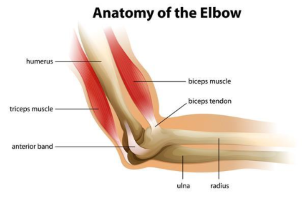
The elbow joint connects the bones of the forearm (the radius on the thumb side and the ulna on the pinky finger side) to the humerus bone of the upper arm. The joint that allows the elbow to bend is the humeroulnarjoint. It is formed by the ulnar protusions, the olecranon and the coronoid, which fit into depressions in the humerus. The joint is surrounded by cartilage, allowing for shock absorbance and smooth gliding of the bones during bending. The biceps and triceps muscles are connected by tendonsallowing for flexion and extension of the elbow.
Radial Head Fracture
What is it?
The radial head is the knobby end of the radius where it meets the elbow. This can be fractured following a fall as the force travels up the forearm bone. Many elbow dislocations also involve a fracture to the radial head.
Symptoms of a radial head fracture include pain on the outside of the elbow, swelling in the elbow joint, difficulty bending or straightening the elbow, and inability to turn the forearm.
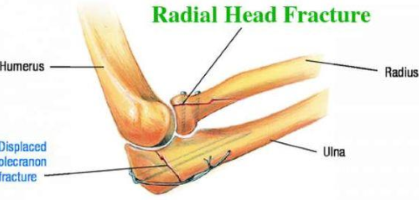
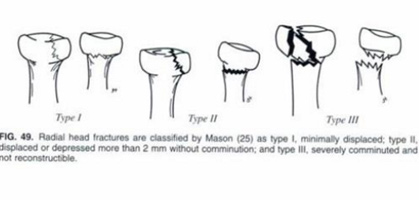
Type I: Small, bone pieces remain fitted together
Type II: Slightly displaced and involved a larger piece of bone
Type III: Multiple broken pieces of bone which cannot be put back together
Treatments
Nonsurgical
For a Type I fracture or Type II with minimal displacement patients may only require a sling or splint to hold the bones in place during healing. If the bones shift,surgery may be required. After 1-2weeks the patient can begin moving the elbow and physicaltherapy may be started. Heavylifting should be avoided for 6-8weeks.
Open Surgical
For a large Type II or a Type III fracture open surgery may be required to remove the broken pieces and repair the soft-tissue damage. If the damage is severe the entire radial head may need to be removed and an elbow replacement may be performed (see below).
Distal Humerus Fracture
What is it?
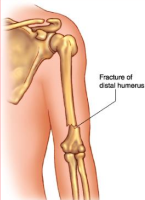
The distal humerus is the part of the elbow that sits within the protrusion of the ulna,allowing elbow motion. A fracture to the distal humerus may occur following a fall or a collision with a hard object at the elbow.
Symptoms of a distal humerusfracture include severe pain, a feeling of instability as if the elbow wants to pop out, bruising, and swelling.
Treatment
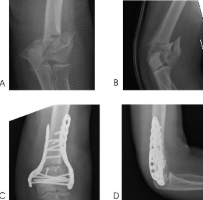
Open surgery is conducted to put the pieces of the bone back together. A combination of plates and screws will be used to hold thepieces in place. If the fracture is too severe to fix with these tools an elbow replacement may be necessary (see below).







